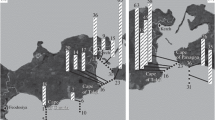Abstract
Aliphatic and polycyclic aromatic hydrocarbons were studied in water, filtration and separation particulate matter, seston, and bottom sediments with the aim to determine their concentrations and origin and compare them with the concentrations of lipids and Corg (August 2006). The effect of anthropogenic hydrocarbons was identified mostly in the Northern Dvina mouth area and in the apex of Dvina Bay. In other parts of the sea, natural compounds dominate in all examined objects, since anthropogenic hydrocarbon cannot pass through the Northern Dvina-the White Sea geochemical barrier. The low temperatures in the high-latitude water areas are shown not to reduce the rate of diagenetic processes in the sedimentary strata.
Similar content being viewed by others
References
Agatova, A.I., Lapina, N.M., and Kirpichev, K.B., Organic Matter in Sediments of Kandalaksha Bay, White Sea, Geokhimiya, 2002, no. 7, pp. 734–741 [Geochem. Int. (Engl. Transl.), no. 7, pp. 664–671].
Demina, L.L. and Nemirovskaya, I.A., Spatial Distribution of Microelements in the Seston of the White Sea, Okeanologiya, 2007, vol. 47, no. 3, pp. 90–102 [Oceanology (Engl. Transl.), vol. 47, no. 3, pp. 360–372].
Elisov, V.V., Assessment of Water Mass Volumes in the White Sea, Meteorol. Gidrol., 1999, no. 9, pp. 78–85.
Izrael’, Yu.A., and Tzyuban, A.V., Antropogennaya Ekologiya Okeana, (Antropogenic Ecology of the Ocean), L.: Gidrometeoizdat, 1989.
Katastrofa tankera “Globe Asimi” v portu Klaipeda i ee ekologicheskie posledstviya (Globe Asimi Tanker Catastrophe in Klaipeda Port and Its Environmental Consequences), Moscow: Gidrometeoizdat, 1990.
Kravchishina, M.D, Material Composition of Particulate Matter in the White Sea Water, Extended Abstract of Cand. Sci. (Geol.-Miner.) Dissertation, Moscow: IORAN, 2007.
Kravchishina, M.D. and Shevchenko, V.P., First Determinations of the Grain Size Composition of Suspended Particulate Matter in the White Sea, Dokl. Akad. Nauk, 2005, vol. 400, no. 3, pp. 387–391 [Dokl. (Engl. Transl.), vol. 400, no. 3, pp. 140–144].
Kuznetsov, A.N., Regularities in Oil Pollution Transformation in Aquatic Ecosystems, Extended Abstract of Cand. Sci. (Geogr.) Dissertation, Rostov-on-Don: RGU, 2005.
Lisitsyn, A.P., Marginal Filter of Oceans, Okeanology, 1994, vol. 34, no. 5, pp. 735–747 [Oceanology (Engl. Transl.), 1995. vol. 34, no. 5, pp. 671–682].
Lisitsyn, A.P., New Potentialities of Four-Dimensional Oceanology and Second-Generation Monitoring: Experience of Two-Year Studies in the White Sea, in Aktual’nye problemy okeanologii (Urgent Problems of Oceanology), Moscow: Nauka, 2003, pp. 503–556.
Lyutsarev, S.V., Determination of Organic Carbon in Marine Bottom Deposits by Dry Ignition Technique, Okeanologiya, 1986, vol. 26, no. 4, pp. 704–708.
Metodicheskie ukazaniya. Opredelenie zagryaznyayushchikh veshchestv v probakh morskikh donnykh otlozhenii. RD 52.10.556-95 (Methodological Recommendations. Determination of Pollutants in Samples of Marine Bottom Sediments), Moscow: Gidrometeoizdat, 1996.
Metody issledovaniya organicheskogo veshchestva v okeane (Methods for Studying Organic Matter in the Ocean), Moscow: Nauka, 1980.
Nemirovskaya, I.A., Uglevodorody v okeane (sneg — led — voda — vzves’ — donnye osadki) (Hydrocarbons in the Ocean: Snow-Ice-Water-Particulate Matter-Bottom Sediments), Moscow: Nauch. mir, 2004.
Nemirovskaya, I.A., Hydrocarbons in the White Sea: Routes and Forms of Migration and Genesis, Geokhimiya, 2005, no. 5, pp. 542–554 [Geochem. Int. (Engl. Transl.), no. 5, pp. 493–504].
Nemirovskaya, I.A., Hydrocarbons in the Ecosystem of the White Sea, Okeanologiya, 2005, vol. 45, no. 5, pp. 678–688 [Oceanology (Engl. Transl.), vol. 45, no. 5, pp. 639–649].
Nemirovskaya, I.A., Hydrocarbons in the Bottom Sediments of the Northern Dvina Estuary, Vodn. Resur., 2007, vol. 34, no. 6, pp. 699–706 [Water Resour. (Engl. Transl.), vol. 34, no. 6, pp. 699–706].
Rovinskii, F.Ya., Teplitskaya, T.A., and Alekseeva, T.A., Fonovyi monitoring politsiklicheskikh aromaticheskikh uglevodorodov (Background Monitoring of Polycyclic Aromatic Hydrocarbons), Leningrad: Gidrometeoizdat, 1988.
Rybalko, A.E. and Fedorova, N.K., Oxidation Zone in Bottom Sediments and Its Significance in Geoecological Studies, in Geologiya morei i okeanov (Geology of Seas and Oceans), Moscow: GEOS, 2007, vol. 2, pp. 279–281.
Savvichev, A.S., Rusanov, I.I., Yusupov, S.K., et al., Microbial Processes of the Organic Matter Transformation in the White Sea, Okeanologiya, 2005, vol. 45, no. 5, pp. 689–702 [Oceanology (Engl. Transl.), vol. 45, no. 5, pp. 650–663].
Bouloubassi, I. and Saliot, A., Investigation of Anthropogenic and Natural Organic Inputs in Estuarine Sediments Using Hydrocarbon Markers (NAN, LAB, PAH), Oceanol. Acta, 1993, vol. 16, no. 2, pp. 145–161.
Carls, M.G., Short, J.F., and Payne, J., Accumulation of Polycyclic Aromatic Hydrocarbons by Neocalanus Copepods in Port Valdez, Alaska, Mar. Pol. Bul., 2006, vol. 52, no. 11, pp. 1480–1489.
Dai, M., Martin, J.M., and Cauved, G., The Significant Role of Colloids in the Transport and Transformation of Organic Carbon and Associated Trace Metals (Cd, Cu and Ni) in the Rhone Delta (France), Mar. Chem., 1995, vol. 51, no. 1, pp. 159–175.
Marti, S., Bayona, J.M., and Mejanelle, L., Biogeochemical Evolution of the Outflow of the Mediterranean Deep-Lying Particulate Organic Matter Into the Northeastern Atlantic, Mar. Chem., 2001, vol. 76, no. 2, pp. 211–231.
Saliot, A., Goutx, M., Fefrier, A., et al., Organic Sedimentation in the Water Column in the Arabian Sea; Relationship between the Lipid Composition of Small and Large-Size, Surface and Deep Particle, Mar. Chem., 1982, vol. 11, no. 3, pp. 257–278.
Tolosa, I., Mora, S., Sheikholeslami, M.R., et al., Aliphatic and Aromatic Hydrocarbons in Coastal Caspian Sea Sediments, Mar. Pol. Bul., 2004, vol. 48, no. 1, pp. 44–60.
Venkatesan, M.J. and Kaplan, I.R., Distribution and Transport of Hydrocarbons in Surface Sediments of the Alaskan Outer Continental Shelf, Geochim. Cosmochim. Acta, 1982, vol. 46, pp. 2135–2149.
Wakeham, S.G., Aliphatic and Polycyclic Aromatic Hydrocarbons in Black Sea, Mar. Chem., 1996, vol. 53, no. 2, pp. 187–205.
Wu, Y., Zhang, J., Mi, T., and Li, B., Occurrence of N-Alkanes and Polycyclic Aromatic Hydrocarbons in the Core Sediments of the Yellow Sea, Mar. Chem., 2001, vol. 76, no. 1, pp. 1–15.
Author information
Authors and Affiliations
Additional information
Original Russian Text © I. A. Nemirovskaya, 2009, published in Vodnye Resursy, 2009, Vol. 36, No. 1, pp. 68–79.
Rights and permissions
About this article
Cite this article
Nemirovskaya, I.A. Hydrocarbons in the water, particulate matter, seston, and bottom sediments of the White Sea in the late summer. Water Resour 36, 64–75 (2009). https://doi.org/10.1134/S0097807809010060
Received:
Published:
Issue Date:
DOI: https://doi.org/10.1134/S0097807809010060




